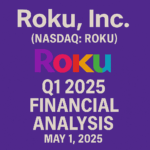OLAPLEX Holdings, Inc. (NASDAQ: OLPX)
Q1 2025 Financial Analysis | May 8, 2025
Executive Summary
OLAPLEX reported a solid start to Q1 2025 with sales coming in ahead of management's expectations, despite a 1.9% year-over-year decline to $97.0 million. The company continues to make progress on its transformation and "Bonds and Beyond" strategy. Performance varied across channels, with Specialty Retail increasing 12.0% to $38.6 million, while Professional and Direct-To-Consumer channels experienced declines of 10.9% and 7.2%, respectively. Net income decreased significantly to $0.5 million from $7.7 million in Q1 2024, largely due to increased SG&A expenses and lower gross margins. The company reiterated its full-year 2025 guidance and voluntarily repaid $300 million of outstanding long-term debt on May 1, 2025, using available cash on hand.
Q1 2025 Highlights
Financial Performance
OLAPLEX's Q1 2025 financial performance showed mixed results, with net sales decreasing 1.9% year-over-year to $97.0 million. Despite this overall decline, the company noted that sales came in ahead of management's expectations, signaling some positive momentum in the business transformation. By geographic region, net sales increased 0.6% in the United States but decreased 4.5% internationally, suggesting stronger domestic performance.
Gross profit decreased 5.6% to $67.4 million, with gross profit margin contracting 260 basis points to 69.5%. Adjusted gross profit, which excludes amortization of patented formulations, was $69.7 million (71.9% margin), compared to $73.5 million (74.3% margin) in Q1 2024. This margin pressure indicates higher costs of production relative to sales.
SG&A expenses increased significantly by 18.7% to $48.0 million, compared to $40.4 million in Q1 2024. This substantial increase in operating expenses, combined with lower sales, contributed to the sharp decline in profitability. Adjusted SG&A, which excludes share-based compensation, certain litigation expenses, and executive reorganization costs, increased 19.1% to $44.3 million.
Net income decreased dramatically to $0.5 million from $7.7 million in Q1 2024, representing a 94.0% decline. This resulted in diluted EPS of $0.00, compared to $0.01 in the prior year period. The significant reduction in profitability reflects both top-line pressure and increased operating expenses.
Adjusted EBITDA, a key measure of operating performance, declined 27.7% to $25.7 million, with adjusted EBITDA margin contracting substantially from 35.9% to 26.5%. This 940 basis point margin decline highlights the pressure on the company's operating model during this transformation period.
Channel Performance
| Channel | Q1 2025 ($M) | Q1 2024 ($M) | % Change | % of Total Sales |
|---|---|---|---|---|
| Specialty Retail | $38.6 | $34.5 | +12.0% | 39.8% |
| Professional | $34.5 | $38.7 | -10.9% | 35.6% |
| Direct-To-Consumer | $23.9 | $25.7 | -7.2% | 24.6% |
Specialty Retail was the standout performer in Q1 2025, with sales increasing 12.0% year-over-year to $38.6 million. This channel now represents approximately 39.8% of OLAPLEX's total sales, up from 34.9% in Q1 2024. The strong performance in Specialty Retail suggests that the company's strategy to expand its presence in this channel is showing positive results and resonating with consumers in brick-and-mortar retail environments.
Professional channel sales decreased 10.9% to $34.5 million, accounting for approximately 35.6% of total sales. This decline in the Professional channel, traditionally one of OLAPLEX's core strengths, could indicate challenges in salon adoption, competitive pressures, or a strategic shift in the company's go-to-market approach. The Professional channel has historically been an important driver of brand awareness and credibility for OLAPLEX.
Direct-To-Consumer (DTC) channel sales decreased 7.2% to $23.9 million, representing approximately 24.6% of total sales. The decline in DTC sales may reflect broader e-commerce challenges in the beauty industry, changes in consumer purchasing behavior, or increased competition in the digital space. Given the typically higher margins in DTC sales, this decline may also have contributed to the overall margin pressure experienced in the quarter.
The divergent performance across channels highlights the evolving nature of OLAPLEX's business model and the ongoing transformation in its distribution strategy. The significant growth in Specialty Retail, coupled with declines in Professional and DTC, suggests that the company is experiencing a shift in how consumers engage with and purchase its products. This shift may be part of the company's deliberate strategy to diversify its revenue streams and reduce dependence on any single channel.
Geographically, the company experienced a 0.6% increase in U.S. sales while international sales decreased by 4.5%. This suggests that domestic market initiatives are gaining more traction than international efforts, potentially indicating a need for more tailored strategies in overseas markets.
Balance Sheet and Cash Flow
As of March 31, 2025, OLAPLEX maintained a strong balance sheet position:
- Cash and Cash Equivalents: $580.9 million, slightly down from $586.0 million at December 31, 2024
- Inventory: $79.2 million, up from $75.2 million at the end of 2024, representing a 5.3% increase
- Accounts Receivable: $23.8 million, up from $14.9 million at December 31, 2024, a significant 59.7% increase
- Long-term Debt: $642.4 million (net of current portion and deferred debt issuance costs), compared to $643.7 million at December 31, 2024
In a significant post-quarter development, OLAPLEX voluntarily repaid $300.0 million of outstanding long-term debt on May 1, 2025. This repayment was funded using available cash on hand and did not result in prepayment penalties or fees. This debt reduction demonstrates management's commitment to strengthening the company's balance sheet and reducing financial leverage.
Cash flow metrics for the quarter showed some challenges:
- Net cash used in operating activities was $2.9 million, compared to net cash provided by operating activities of $43.7 million in Q1 2024
- Net cash used in investing activities was $1.0 million, relatively unchanged from $1.1 million in Q1 2024
- Net cash used in financing activities was $1.2 million, compared to $1.5 million in Q1 2024
The shift from generating positive operating cash flow in Q1 2024 to consuming cash in Q1 2025 reflects the decline in profitability and changes in working capital, particularly the increase in accounts receivable and inventory. Despite these quarterly challenges, OLAPLEX's substantial cash position provides significant financial flexibility and supports the company's ability to make strategic investments and manage through its transformation period.
The increase in accounts receivable may indicate slower collection cycles or changing payment terms with retail partners, while the inventory build suggests preparation for anticipated future demand or potential supply chain optimization. These working capital dynamics will be important to monitor in future quarters as indicators of operational efficiency.
Strategic Initiatives and Outlook
OLAPLEX continues to execute on its transformation journey and "Bonds and Beyond" strategy, with several key initiatives and outlook points noted:
Strategic Initiatives
- Incremental Marketing Investment: The company began increasing its marketing investment at the end of Q1 2025, with Q2 2025 expected to reflect a full quarter of this incremental investment
- "Bonds and Beyond" Strategy: Continued focus on expanding beyond the core bond-building technology that made OLAPLEX famous, likely including new product categories and formulations
- Channel Optimization: The significant growth in Specialty Retail suggests deliberate emphasis on expanding brick-and-mortar distribution
- Innovation Pipeline: Management referenced continued investment in research and development to increase the innovation pipeline
- Execution Capabilities: Efforts to strengthen execution capabilities, including investments in talent
Fiscal Year 2025 Guidance
OLAPLEX reiterated its guidance for fiscal year 2025, which was initially disclosed on March 4, 2025:
- Net Sales: $410 - $431 million (2024 actual: $423 million)
- Adjusted Gross Profit Margin: 70.5% to 71.5% (2024 actual: 71.4%)
- Adjusted EBITDA Margin: 20% to 22% (2024 actual: 30.7%)
The company's guidance reflects significant expected pressure on the Adjusted EBITDA margin, projecting a substantial decline from 30.7% in 2024 to 20-22% in 2025. This forecast contraction illustrates the increased investments the company is making in marketing, research and development, and talent as part of its transformation strategy. The maintained revenue guidance, which implies flat to slight growth compared to 2024, suggests management expects the strategy to stabilize sales during 2025, potentially setting up a return to growth in future periods.
Management's outlook incorporates the current consumer spending environment and assumes no material impact from tariffs. The guidance also reflects expectations for the continued implementation of OLAPLEX's investments and actions aimed at generating demand, increasing its innovation pipeline, and strengthening execution capabilities.
The decision to maintain guidance following Q1 results that exceeded sales expectations suggests management is taking a prudent approach, recognizing the ongoing challenges in the beauty industry while remaining focused on long-term strategic objectives rather than short-term quarterly fluctuations.
Risks & Opportunities
Opportunities
Risks
Conclusion
Strengths
- Strong growth in Specialty Retail channel (+12.0%)
- Solid cash position ($580.9 million)
- Proactive debt reduction ($300 million repayment)
- Positive U.S. market performance (+0.6%)
- Maintained full-year guidance despite challenges
Areas for Improvement
- Declining Professional and DTC channel performance
- Significant margin compression (Adjusted EBITDA margin -9.4pts)
- International market weakness (-4.5%)
- Negative operating cash flow (-$2.9 million)
- Rising SG&A expenses (+18.7%)
Summary
OLAPLEX's Q1 2025 results reflect a company in transition, with mixed performance across channels and regions. While overall net sales decreased 1.9% to $97.0 million, management noted that sales exceeded expectations, suggesting some positive momentum in the business transformation. The standout performer was the Specialty Retail channel, which grew 12.0% to $38.6 million, while Professional and Direct-To-Consumer channels experienced declines of 10.9% and 7.2%, respectively.
Profitability metrics showed more significant challenges, with net income declining 94.0% to $0.5 million and Adjusted EBITDA decreasing 27.7% to $25.7 million. These declines reflect both margin pressure and increased SG&A expenses as the company invests in its transformation initiatives. The Adjusted EBITDA margin contracted substantially from 35.9% to 26.5%, highlighting the financial impact of this investment phase.
OLAPLEX's balance sheet remains strong, with $580.9 million in cash and cash equivalents. The company demonstrated its financial flexibility by voluntarily repaying $300 million of long-term debt shortly after the quarter ended, using available cash on hand. This debt reduction strengthens the company's financial position as it navigates its transformation journey.
Looking ahead, OLAPLEX reiterated its full-year 2025 guidance, projecting net sales of $410-$431 million and an Adjusted EBITDA margin of 20-22%. Management expects Q2 2025 to reflect a full quarter of incremental marketing investment that began at the end of Q1. The maintained guidance, despite a challenging start to the year, suggests confidence in the company's ability to navigate the dynamic environment and deliver on its strategic objectives. The success of the "Bonds and Beyond" strategy and the company's ability to revitalize growth in the Professional and DTC channels will be critical factors to watch in upcoming quarters.
Source: OLAPLEX Q1 2025 Earnings Release






